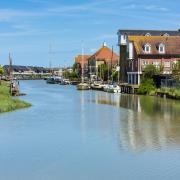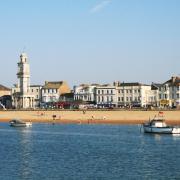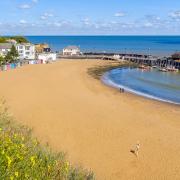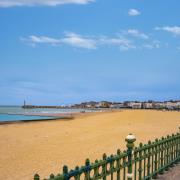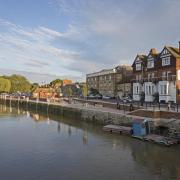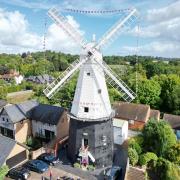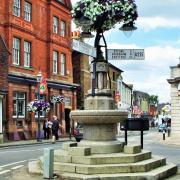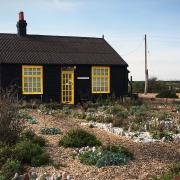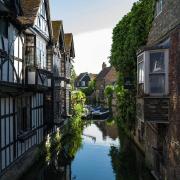With Ash dieback on the increase, we look at how a Kent project is celebrating this much-loved tree’s special place in local culture

If the English were asked to nominate their choice of national tree, the majority vote would almost certainly go to the oak, but they wouldn’t be wrong to go for the ash.
In Kent, the county with the largest surviving acreage of ancient woodland, the latter is the most populous tree on the undulating chalk escarpments of the Kent Downs, stitched into the fabric of the local heritage.
So it’s fitting that at the top of a blustery North Downs hill, with serene views across the Weald to the Greensand Ridge, stands a beautiful monument to a much-loved species.
Ash to Ash, unveiled in the summer of last year, consists of a pair of monolithic sculptural artworks created by Ackroyd and Harvey, the multi-disciplinary artist team of Heather Ackroyd and Dan Harvey.
It’s not their first tree-themed project, the pair having produced History Trees for the Olympic Park in London in 2012, but the story behind Ash to Ash has a special cultural resonance.
The species has an extremely productive hardwood, yielding more timber than any other native British tree except beech. In Kent it also has immense historical value, says Madeleine Hodge of the Ash Project.
Under the aegis of the Kent Downs Area of Outstanding Natural Beauty, she has overseen the Ash to Ash installation as part of a broader initiative called The Ash Project.
“Kent in the medieval period was divided into hundreds, each of which had a body of men trained and ready to bear arms for the king,” she explains. “It became known as the archer’s county, and with the supply of ash being so plentiful, it was seen as the archer’s wood, used in the making of arrows and longbows.

It was this that gave the artists some of the inspiration for the Ash to Ash sculpture, which consists of the stripped, treated and charred trunks of two felled trees, and 11,000 ash arrows hand drilled and dried, and inserted into the trunk.”
The twin trees form a single sculpture standing 10m (33ft) high in White Horse Wood Country Park on the outskirts of Maidstone, at the top of a road that winds up beyond the Norman ruins of Thurnham Castle.
According to Norse mythology, the vigorously growing ash was considered the World Tree, but while the arrows represent the productivity of its timber, they also symbolise the jeopardy of its future. As part of its strategy to resist infection, ash trees produce dozens of naturally occurring small shoots along the main trunk and branches via a system known as epicormic growth.
The arrows on one level can be seen as representative of epicormic vigour but, on another, to represent a coat of spears, battling to offset the devastating effects of the Chalara ash dieback disease.
Present in European countries since the 1990s, Chalara ash dieback, caused by a fungal disease, was first reported in Britain among imported ash trees in a Norfolk tree nursery in 2012. Madeleine says it was probably present in Kent for at least three years before that.
“It’s in every square kilometre of this county now. It’s not possible to contain it anywhere. It’s a virulent, wind-borne fungus that infects through the stem of the leaf.”
Symptoms include wilting leaves and cankers on young shoots, first appearing at the top of a tree, leading to dieback of the crown, before the symptoms spread lower down the tree.
Infected young trees will die within a few years, while older trees may last 10 to 20 years years before felling is required.
Apart from the impact on timber sources, it’s going to be devastating for Kent’s landscapes, to the point of being irreplaceable, says Madeleine.
“Ash in a woodland setting grows taller than companion trees such as oak or hazel, and you’ll often see them as marker trees on farm boundaries, their tops high above the canopy line of other species. There are also lots along the pilgrim routes of the North Downs Way, where they were often planted, probably as part of a ceremonial marking of the dead.
“There’s a folklore tradition of planting an ash when a child is born, and of cleaving an ash and passing the baby through it to make its body strong. There are stories about our ancestors feeding ash sap to babies to make them strong.”
Just by the path leading to the flint walls of Thurnham Castle, there’s an old ash, broad of girth, its centuries old roots protruding wall-like on the bank.
Ashes are monuments to the spirit of non-conformity, of not towing the party line. Unless in a group of saplings shooting up together in a clearing, they come in a variety of shapes.
They have huge spreading canopies, and sometimes the trunks have strange bends like dog’s legs, due to a forking of the bole in youth.
The almost reptilian fissures of the bark in maturity, the distinctive orange or reddish hues the grey-brown barks take on as a favoured host tree for lichens, and the dry, cane-like rattling of smaller branches in the wind, as well as the lovely, dappling effect of the slender, pinnate leaves, are all reasons why we will miss the ash.
The UK has been here before, but you’d need to be quite advanced in years to recall the time when the English Elm was a common and majestic site in the landscape before Dutch elm disease all but wiped it out in the 1970s.
This time there’s more hope, argues Madeleine, with signs that some ash trees have a natural resistance to Chalara ash dieback. A related project, the Living Ash Project has been tagging these trees, so that if they survive, their resistance might be exploited by tree breeders.
“We won’t be around to see them in their maturity, which is why it’s so important to make the most of them now. As part of the Ash Project, a cultural project that celebrates our material and spiritual relationship with ash, we’ve worked with more than 30 artists, woodworkers and designers, which shows just how versatile and loved this tree is.
“We have created an online Ash Archive and want people to send in photographs of ash trees and landscapes that are important to them, so that we have examples of good ash sites and individual trees, so we can regenerate them in the future,” says Madeleine.
She also thinks the decline of the ash has parallels with wider fears about the environment.
“We brought this disease upon ourselves via the global trading and importing of trees and accompanying diseases which probably started to increase from the 1970s, destroying the more tangible relationship to the nature of our more immediate environment we once had.”
You can mourn the loss of Africa’s rhinos while recalling that we purposely eradicated most of our wild species centuries ago. But the ash, which sprouts up almost anywhere, is a wild thing too and how we react to its decimation will say much about how we are planning to respond to the climate emergency, or the ongoing loss of flora and fauna both in this country and around the world.
Madeleine’s favourite Kent ash tree sites
White Horse Country Park Wood, Maidstone
Home to the Ash to Ash sculpture.
Hucking Estate, Hollingbourne
Owned by the Woodland Trust, home to many examples of large ash trees, and a test site for resistance to the Chalara ash dieback fungus.
Ash Holt Woods, on the Folkestone Downs
The wood is a Site of Special Scientific Interest, with its ancient ash trees cited in the designation
Cobham Wood and Mausoleum, Cobham
National Trust property which also has many fine veteran ash trees.
Sissinghurst Gardens, Sissinghurst
An avenue of ancient ash just off the main garden site.
The Ash Project was funded by the Heritage Lottery Fund, Arts Council England and Kent County Council. It was commissioned by the Kent Downs Area of Outstanding Natural Beauty, with additional funding from the Woodland Trust and North Downs Way: www.theashproject.org.uk






